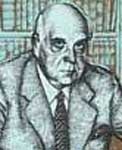.
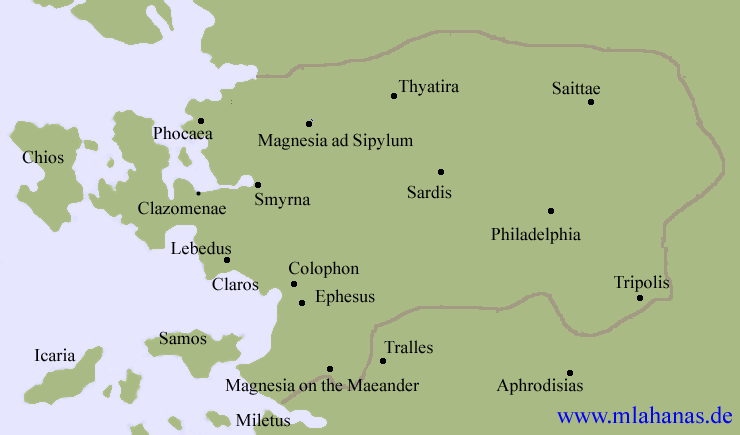
Smyrna (in Greek "Σμύρνη"; see also List of traditional Greek place names) (now Izmir, Turkey) was settled at the beginning of the 3rd millennium BC. Throughout Antiquity it was the early leading city-state of Greek Ionia, on the Aegean shores and islands of Asia Minor. Smyrna was among the cities that claimed Homer as a resident. Modern Turkish interpretations emphasize Smyrna's earlier connections with the Hittite empire of central Anatolia.
Smyrna is said to have been a city of the autochthonous Leleges before the Greek colonists settled in the coast of Asia Minor. The name, which Greek myth derived from an eponymous Amazon named Smyrna, was applied also to a quarter of Ephesus, and can also be recognized under the form Myrina, a city of Aeolis. The early Aeolian Greek settlers of Lesbos and Cyme, expanding eastwards, occupied the valley of Smyrna. It was one of the confederacy of Aeolian city-states, marking the Aeolian frontier with the Ionian colonies. Strangers or refugees from the Ionian city of Colophon settled in the city and finally (traditionally in 688 BC) by an uprising Smyrna passed into their hands and became the thirteenth of the Ionian city-states. Revised mythologies made it a colony of Ephesus (Strabo xiv. 633 BC; Stephanus Byzantinicus; Pliny, Nat. Hist. v.31) In 688 BC the Ionian boxer Onomastus of Smyrna won the prize at Olympia, but the coup was probably then a recent event. The Colophonian conquest is mentioned by Mimnermus (before 600 BC), who counts himself equally of Colophon and of Smyrna. The Aeolic form of the name was retained even in the Attic dialect, and the epithet "Aeolian Smyrna" remained current long after the conquest.
Smyrna's position at the mouth of the small river Hernus at the head of a deep arm of the sea (Smyrnaeus Sinus) that reached far inland and admitted Greek trading ships into the heart of Lydia, placed it on an essential trade route between Anatolia and the Aegean and raised Smyrna during the 7th century BC to power and splendor. One of the great trade routes which cross Anatolia descends the Hermus valley past Sardis, and then diverging from the valley passes south of Mount Sipylus and crosses a low pass into the little valley where Smyrna lies between the mountains and the sea. Miletus, and later Ephesus, situated at the sea end of the other great trade route across Anatolia, competed for a time successfully with Smyrna, but after both cities' harbors silted up, Smyrna remained without a rival.
The river Meles, which flowed by Smyrna, is famous in literature and was worshipped in the valley. A common and consistent tradition connects Homer with the valley of Smyrna and the banks of the Meles; his figure was one of the stock types on coins of Smyrna, one class of which numismatists call "Homerian"; the epithet Melesigenes was applied to him; the cave where he was wont to compose his poems was shown near the source of the river; his temple, the Homereum, stood on its banks. The steady equable flow of the Meles, alike in summer and winter, and its short course, beginning and ending near the city, are celebrated by Aristides and Himerius. The description applies admirably to the stream which rises from abundant springs east of the city and flows into the southeast extremity of the gulf.
The archaic city ("Old Smyrna") contained a Temple of Athena from the 7th century BC.
Lydian Smyrna
When the Mermnad kings raised the Lydian power and aggressiveness, Smyrna was one of the first points of attack. Gyges (ca. 687–652) was, however, defeated on the banks of the Hermus, the situation of the battlefield showing that the power of Smyrna extended far to the east. A strong fortress, the ruins of whose ancient and massive walls are still imposing, on a hill in the pass between Smyrna and Nymphi, was probably built by the Smyrnaean Ionians to command the valley of Nymphi. According to Theognis (about 500 BC), pride destroyed Smyrna. Mimnermus laments the degeneracy of the citizens of his day, who could no longer stem the Lydian advance. Finally, Alyattes III (609-–560 BC) conquered the city and sacked it, and though Smyrna did not cease to exist, the Greek life and political unity were destroyed, and the polis was reorganized on the village system. Smyrna is mentioned in a fragment of Pindar and in an. inscription of 388 BC, but its greatness was past.
Hellenistic Smyrna
|
|
|
Alexander the Great conceived the idea of restoring the Greek city, in a scheme that was, according to Strabo, actually carried out under Antigonus (316-–301 BC) and Lysimachus, who enlarged and fortified the city (301-–281 BC). The ruined acropolis of the ancient city, the "crown of Smyrna," had been on a steep peak about 1250 ft. high, which overhangs the northeast extremity of the gulf. The later, Hellenistic city was founded on the modern site of Izmir, partly on the slopes of a rounded hill the Greeks called Pagus near the southeast end of the gulf, and partly on the low ground between the hill and the sea. The beauty of the Hellenistic city, clustering on the low ground and rising tier over tier on the hillside, was frequently praised by the ancients and is celebrated on its coins.

Smyrna Tetradrachm , Kybele (Cybele), Oak wreath, Text SMYRNAION, there was a temple of Kybele in Smyrna
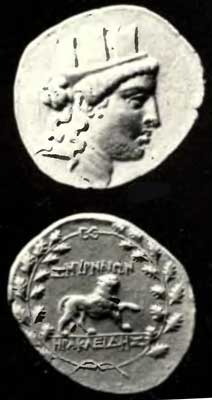
Smyrna Tetradrachm, Kybele, walking lion, Text SMYRNAION, HERAKLEIDES, 2nd cent. BC, the lion is associated with Kybele
Smyrna is shut in on the west by a hill now called Deirmen Tepe, with the ruins of a temple on the summit. The walls of Lysimachus crossed the summit of this hill, and the acropolis occupied the top of Pagus. Between the two the road from Ephesus entered the city by the Ephesian gate, near which was a gymnasium. Closer to the acropolis the outline of the stadium is still visible, and the theatre was situated on the north slopes of Pagus. Smyrna possessed two harbours, the outer, which was simply the open roadstead of the gulf, and the inner, which was a small basin, with a narrow entrance, partially filled up by Timur in 1402.
The streets were broad, well paved and laid out at right angles; many were named after temples: the main street, called the Golden, ran across the city from west to east, beginning probably from the temple of Zeus Akraios on the west slope of Pagus, and running round the lower slopes of Pagus (like a necklace on the statue, to use the favorite terms of Aristides the orator) towards Tepejik outside the city on the E., where probably stood the temple of Cybele, worshipped under the name of Meter Sipylene, (from Mt. Sipylus, which bounds the Smyrna valley), the patroness of the city. The plain towards the sea was too low to be properly drained and hence in rainy weather the streets were deep with mud and water.
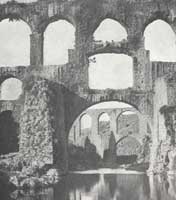
Smyrna Aqueduct
Roman and Byzantine Smyrna
In the Roman period Smyrna vied with Ephesus and Pergamum for the title First City of Asia. A Christian church existed here from a very early time, having its origin in the considerable Jewish colony. Polycarp, bishop of Smyrna, was martyred AD 153. The bishops of Smyrna were originally subject to the metropolitan of Ephesus; afterwards they became independent.
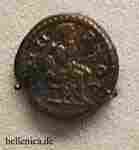
When Constantinople became the seat of government the trade between Anatolia and the west lost in importance, and Smyrna declined. A Seljuk pirate named Tsacha seized Smyrna in 1084, but it was recovered by the generals of Alexius Comnenus. The city was several times ravaged by the Turks, and had become quite ruinous when the emperor John Ducas Vatatzes about 1222 rebuilt it. But Ibn Batuta found it still in great part a ruin when the famous chieftain Aidin had conquered it about 1330 and made his son Amur governor. It became the port of the Aidin amirate. Soon afterwards the Knights of Saint John established themselves in the town, but failed to conquer the citadel. In 1402 Timur stormed the town and massacred almost all the inhabitants. The Mongol conquest was only temporary, but Smyrna was resumed by the Seljuks of Aidin and remained Ottoman and then Turkish. Until the reign of Abdul Mejid it was included for administrative purposes in the vilayet of Jezair ("the Isles") and not in that of Anadoli. The representative of the Capitan Pasha, who governed that eyalet, was, however, less influential in the city than the head of the Kara Osman Oglus of Manisa. From the early 17th century till 1825, Smyrna was the chief provincial factory of the British Turkey Company, as well as of French, Dutch and other trading corporations. The passages with gates at each end within which most Frank shops in modern Smyrna lie, are a survival of the semi-fortified residences of the European merchants.
Western sources (such as the Catholic Encyclopedia 1908) estimated that shortly before World war I Smyrna had a population of at least 300,000, of whom 150,000 were Greeks. There were also numerous Jews and Armenians and almost 10,000 European Catholics living in the city at the close of the Ottoman empire.

Image from Smyrna
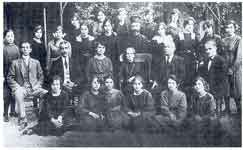
Girl School Omirio (named after Homer) in Smyrna
The Burning of Smyrna
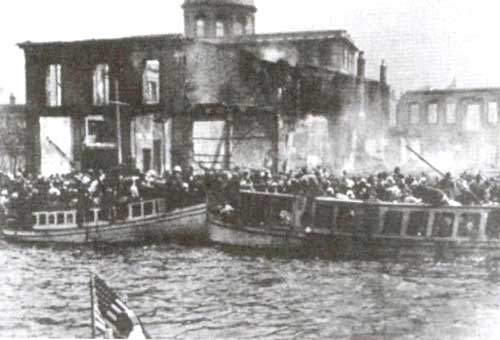
Burning Smyrna
In 1922, the nationalist movement led by Mustafa Kemal Atatürk sought to revoke the Treaty of Sevres following the defeat of the Ottoman empire in World War I. The treaty planned to cede parts of eastern Thrace and Asia Minor to Greece, including the city of Smyrna. The city was occupied on May 15th 1919 by Greece with Allied approval. By 1922, the Greek forces which had pushed into Anatolia were driven back to the sea and in September 1922 Smyrna was recaptured. Many Armenians and Greeks were killed when the Turkish army reoccupied Smyrna. While the historian Kinross referred to the deaths as individual and sporadic and placed the total at 2,000, Marjorie H. Dobkin reconstructs a more recent and comprehensive account and cites the US Consul at Smyrna's estimate that up to 100,000 people may have perished.
Following Turkish reoccupation, a fire destroyed much of the city. The cause of the fire has never been satisfactorily explained. According to Kinross the fire began when Turks, in trying to round up Armenians to confiscate their arms, besieged a group who had taken refuge in a house. They then decided to burn them out by setting the building alight. According to this account, other Armenians in Smyrna, meanwhile, started another fire elsewhere to divert Turkish attention, and it is argued a strong wind could then have carried both fires from the outskirts of Smyrna inward. Many of the buildings, being of flimsy construction, were reduced to ashes. Some Turks believed the fire to be the continuation of the 'scorched earth' policy of the Greeks, while others believed Armenians had received instructions to burn Smyrna as a sacred duty. The more generally accepted account proposed by most Western scholars, however, is that the Turks burned the Armenian and Greek quarters, and Nur-ed-Din Pasha is accused of starting the fire deliberately in an act of retribution. Some Turkish scholars of the time also appear to maintain that position. Suleyman Kulce , in his book, “Maresal Fevzi Cakmak,” accuses Nur-ed-Din and writes that he “..was responsible for the massacres and the fire.” Falih Rifki Atay, who was also a close confidant of Ataturk, was more direct when he wrote: “Why were we burning Izmir? Were we afraid that we would not be delivering ourselves from the (sway) of the minorities in case the mansions, hotels, and cafes were left to remain? Driven by the same fear we put to the torch all the inhabitable quarters and neighborhoods of the Anatolian cities and towns during the World War I Armenian deportations.” He also blamed Nur-ed-Din.
There exist conflicting eyewitness accounts and evidence over who started the fire. The US consul-general George Horton claimed to have seen uniformed Turkish soldiers pouring petroleum near the US consulate. In 1926 Horton published his eyewitness accounts in a stinging criticism of the foreign policy of the Western Powers, The Blight of Asia [1]. Mark Prentiss, an American industrial engineer, stated that : "Many of us personally saw-and are ready to affirm the statement-Turkish soldiers often directed by officers throwing petroleum in the streets and houses. Vice-Consul Barnes watched a Turkish officer leisurely fire the Custom House and the Passport Bureau while at least fifty Turkish soldiers stood by. Major Davis saw Turkish soldiers throwing oil in many houses. The Navy patrol reported seeing a complete horsehoe of fires started by the Turks around the American school." But after being instructed by his superiors, he changed his version and stated that he saw no petroleum being poured. Furthermore, Prentiss in his last version(sent to Adm. Bristol as a form of a manuscript) claims that Paul Grescovitch, Chief of the Smyrna Fire Department, found evidence to suggest that Armenians were the source of the fire, while Dobkin cites references from the fire department accusing the Turks.
Following the success of the nationalist movement, the Treaty of Sevres was revoked and the Treaty of Lausanne was signed, marking the end of the Greco-Turkish War and incorporating the city of Smyrna, now Izmir, into modern day Turkey.
Persons
Greeks
- Quintus Smyrnaeus , (Fall of Troy)
- Adamantios Korais
|
George Dilboy American Hero, a Greek from Smyrna |
|
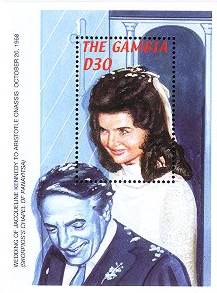
|
|
|
|
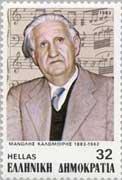
|
Turks
- Nehir Erdoğan, Turkish actress, known also in Greece.
- Yüksel Pazarkaya,
- Ahmet Adnan Saygun
- Alev Tekinay
- Metin Oktay
- Alpay Özalan
Others
- Édouard Balladur
Links
Sources
Smyrna, September 1922: The American Mission to Rescue Victims of the 20th Century's First Genocide Paperback – Illustrated, April 26, 2016
Dobkin, Marjorie H. (1972). Smyrna 1922: The Destruction of a City. Faber & Faber.
Horton, George. (1926). The Blight of Asia (On-line excerpts)
Kinross, Patrick (2003). Ataturk: The Rebirth of a Nation, Phoenix Press. ISBN 1-84212-599-0
Greece :
A - B - C - D - E - F - G - H - I - J - K - L - M -
N - O - P - Q - R - S - T - U - V - W - X - Y - Z
| Ancient Greece
Science, Technology , Medicine , Warfare, , Biographies , Life , Cities/Places/Maps , Arts , Literature , Philosophy ,Olympics, Mythology , History , Images Medieval Greece / Byzantine Empire Science, Technology, Arts, , Warfare , Literature, Biographies, Icons, History Modern Greece Cities, Islands, Regions, Fauna/Flora ,Biographies , History , Warfare, Science/Technology, Literature, Music , Arts , Film/Actors , Sport , Fashion --- |
Retrieved from "http://en.wikipedia.org/"
All text is available under the terms of the GNU Free Documentation License







